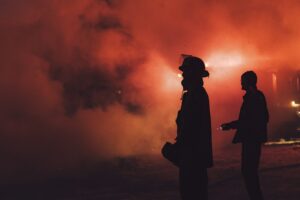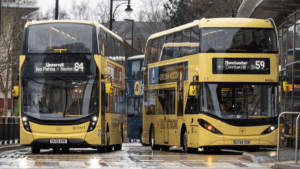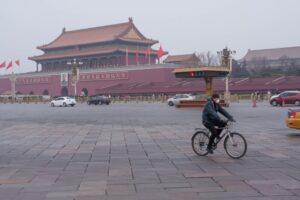A revolution is happening in air quality monitoring. With increasingly affordable air quality sensors, Miriam Gradel explores how we stand a greater chance at monitoring levels across thousands of locations by inviting communities to take part.
With the Clean Air (Human Rights) Bill en-route to becoming a legally-binding act, the pressure is on for UK authorities to make better decisions for combatting air pollution. Speaking in the House of Lords in November 2022, former Labour MP, Baroness Sue Hayman, replied to critics of the proposed act who branded it unnecessary due to the existing framework in the Environment Act: ‘What good is a framework, if you don’t have the overarching targets that are needed to deliver change?’ Take this a step further and the question changes: what good are targets without data to track them?
Co-CEO Ollie Smeenk and Industrial Design Lead Nyckle Sijtsma with the AIRData gaps in air monitoring remain a vital issue in the fight against pollution. In the Netherlands too, ‘a lot of people are afraid of data gaps within the country,’ says Tom de Nooij, Account Manager at Dutch data management company Civity. But by taking a different approach to innovation, the Netherlands is exploring new solutions for and with local populations.
In 2018, the region of Utrecht together with Civity and Internet of Things (IoT) developer SODAQ launched the public-private partnership ‘Snifferbike’. Giving consideration to the country’s vast number of cyclists, the aim of the project was to develop an efficient commuter bike that doubles up as an air quality tracking device. With many citizens using the same route for well up to 30 years, ‘better data on air quality will undeniably have an impact on their life and longevity,’ says de Nooij.
As an expert on using IoT to develop affordable and low-energy tracking devices, SODAQ got involved to ensure the quality of data collected could live up to the same standards of the subsidised air measuring stations. ‘If you want to gather hyper-localised data, you also need to know where you are when you are measuring, and in a very reliable way,’ says Ollie Smeenk, Co-CEO and Chairman of SODAQ. In a one-to-one comparison between the final sensor prototype and reference-grade sensors, the quality of the data was approved by the Dutch Air Quality Network. Now, ‘the authorities encourage all air quality initiatives in the Netherlands to use that specific sensor,’ says Smeenk.
An AIR device fixed to a bikeSince the Snifferbike project first began, the cohesion between authorities and citizens on air pollution has improved. Now regions outside the Netherlands are getting involved and leveraging the Snifferbike technology to help populate a global air quality data map. According to de Nooij, ‘new data inputs also help to paint a clearer picture of how cyclists move’, creating more unity between the public authorities on infrastructure and the environment. With information provision improving, considerations for new bicycle routes have manifested along with more evidence to back public advice on health.
In the UK too, the involvement of local communities and citizens is helping to inform policy makers on air pollution measurements. However, as Dr Theo Damoulas, Professor of Data Science and Machine Learning at the University of Warwick explains, ‘data is not pure information.’ Since 2017, Dr Damoulas has worked as a fellow with the Alan Turing Institute’s London Air Quality programme focusing on integrating data and air pollution measurements from various heterogenous sources into the national air quality map. With no independent authority to qualify sensors, the challenge is not just to populate the data set, but to also make the measurements match.
‘Air pollution is a meta-problem. In order to understand it, you need to first measure it, but also, how well you are measuring it,’ says Dr Damoulas, adding that ‘data is not the end; it is only the beginning.’ Accounting for variables that affect measurements such as environment, frequency and the sensors degrading over time, the project has sought to create effective models for de-noising the data. The next phase of the project is to combine machine-learning and AI to generate predictions for decision-makers with a variety of factors including health, income and population density taken into consideration. In the near future there is also a chance the API itself will be released to the public.
According to Dr Damoulas, educating citizens about the science and how data helps inform policy makers is equally as important as ensuring quality measurements. ‘Informing and involving people in anything that in the end affects the way they live their lives is the base of democracy and improves the participation of citizens,’ says Dr Damoulas. ‘It just needs to be done correctly.’
The correct way, according to SODAQ, takes citizen involvement a notch further. Inspired by the principles of open-source, the company came together with its customers to turn the sensor into a low-cost and energy-efficient bicycle add-on known as the SODAQ Air. All design and manufacturing files are made freely available, rendering it possible for anyone to repair and optimise the device. According to Smeenk, ‘[creating an] impact is more achievable if people can pick up learnings rather than reinventing the wheel. People from all walks of life can very unexpectedly come up with good ideas on how to use the sensor and what impact the data can have.’
Currently, the Air only tracks particulate matter. By continuing with open collaborations, Smeenk hopes to soon be able to upgrade the device to also measure NO2 and NOX. For the Snifferbike, however, Civity is focusing on the user experience. By adding a fitness tracker, de Nooij hopes that more citizens are encouraged to opt for zero-emission options. As de Nooij puts it, with air pollution remaining a significant environmental and socio-economic challenge, ‘if people are encouraged to use their bikes more [through increased air quality data and better infrastructure] then that is a significant move towards to climate neutrality.’
This article first appeared in Air Quality News February 2023.
Read the full version of our latest special issue on transport below.
Images: All images (C) AIR

















Leave a Reply